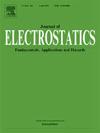灰尘电阻率测量两种板对板电极结构的比较分析
IF 2.1
4区 工程技术
Q3 ENGINEERING, ELECTRICAL & ELECTRONIC
引用次数: 0
摘要
粉尘电阻率是影响静电除尘器效能的一个关键参数,其测量受多种环境和方法因素的影响。在本研究中,在控制温度和湿度的条件下,采用两种板对板电极布置,研究了煤、生物质和混合燃料衍生粉尘样品的比电阻率。排列1使用方形电极和振动压实,而排列2使用圆柱形电极与基于重量的压实和保护环,以减少边缘影响。在加热和冷却循环中进行了6个温度水平(30-180°C)的测量,揭示了从表面到体传导机制的温度和湿度依赖变化。以固定间隔记录随时间变化的电阻率曲线,以捕捉极化效应。结果表明,布置2通常产生较低的电阻率值,这可能是由于压实增强和表面接触增加所致。实验还强调了不同排列之间在可重复性和压实灵敏度上的差异。这些发现有助于更深入地了解粉尘传导机制,并为未来测量方案的设计提供信息。本文章由计算机程序翻译,如有差异,请以英文原文为准。
Comparative analysis of two plate-to-plate electrode configurations for dust resistivity measurement
Dust resistivity is a key parameter in the efficiency of electrostatic precipitators, yet its measurement is influenced by numerous environmental and methodological factors. In this study, the specific resistivity of coal, biomass, and mixed-fuel-derived dust samples was investigated using two plate-to-plate electrode arrangements under controlled temperature and humidity conditions. Arrangement #1 used square electrodes and vibratory compaction, while Arrangement #2 used cylindrical electrodes with weight-based compaction and a guarding ring to reduce edge effects. Measurements were performed across six temperature levels (30–180 °C) in both heating and cooling cycles, revealing temperature- and humidity-dependent shifts from surface to bulk conduction mechanisms. Time-dependent resistivity profiles were recorded at fixed intervals to capture polarization effects. Results indicated that Arrangement #2 generally produced lower resistivity values, likely due to enhanced compaction and increased surface contact. The experiments also highlighted discrepancies in repeatability and compaction sensitivity between arrangements. These findings contribute to a deeper understanding of dust conduction mechanisms and inform the design of future measurement protocols.
求助全文
通过发布文献求助,成功后即可免费获取论文全文。
去求助
来源期刊

Journal of Electrostatics
工程技术-工程:电子与电气
CiteScore
4.00
自引率
11.10%
发文量
81
审稿时长
49 days
期刊介绍:
The Journal of Electrostatics is the leading forum for publishing research findings that advance knowledge in the field of electrostatics. We invite submissions in the following areas:
Electrostatic charge separation processes.
Electrostatic manipulation of particles, droplets, and biological cells.
Electrostatically driven or controlled fluid flow.
Electrostatics in the gas phase.
 求助内容:
求助内容: 应助结果提醒方式:
应助结果提醒方式:


